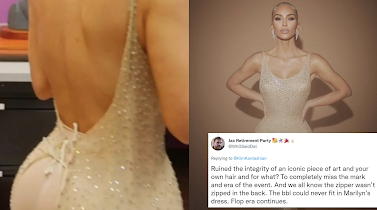Regan Morello
Alert.reganmorello@gmail.com
It comes as no surprise that journalists and advertising professionals are held to a certain set of guidelines or standards when it comes to their work. It is clear that each piece of writing or advertisement released by a company reflects either positively or negatively on the company itself. However, most ads or blogs land somewhere in an ethical gray area. This gray area contains advertisements and articles that stand in front of the advertising ethics guidelines put out by professional companies such as IAE and PRSA and shout "Look at me, I am being ethical!" to distract from the fact that, really, that might not be entirely true.
So how can we tell what is ethical or unethical if the advertisement doesn't fit as perfectly into the guidelines as Kim Kardashian fit in Marylin Monroes dress to the Met Gala this year? Oh wait, this is the example I have been looking for. The situation of advertising ethics can be easily explained if we look at the controversy displayed by the Kim Kardashian and Marylin Monroe's dress Met Gala Situation this year. As far as those viewing the Met Gala could tell, Kim Kardashian fit Marilyn Monroe's dress perfectly, correct? In actuality, it was not as much a perfect fit as meets the eye. In fact, the dress couldn't zip up in the back. Once this news got out, a lot of people began taking to social media to explain how unethical it was for Kim to wear what is considered a historical artifact, especially when she risked damaging it because it didn't fit her.
 |
| People Began Debating on Social Media |
Would it have still been ethical if the dress fit her perfectly? Or was it unethical to begin with? Do advertisement's have to perfectly fit the principles and practices of advertising ethics to be considered ethical? Or will a tiny hidden alteration of these rules set the whole company aflame?
On social media today, as I am sure you have all witnessed, there are many endorsement advertisements made to look as though they aren't sponsored at all. According to principle #4 of IAE's "Principles and Practices for Advertising Ethics," "Advertisers should clearly disclose all material conditions, such as payment or receipt of a free product." On social media, especially in the last 2 years on Tiktok, there are an assortment of low level influencers who promote products through posts where they rave about them, but don't display anywhere in the post that it is sponsored, or rather, a paid advertisement. Even though we can clearly tell (in most circumstances) that a post is sponsored, is it unethical of these companies to not ensure that these influencers display the fact that it is a paid advertisement in their post? Entrepreneur talks about the way Advertisers are capitalizing off Tiktok influencers in their article, "How Brands are Capitalizing Tiktok to Gain New Audiences." I believe it is important, especially for this principle, that this information is displayed. In these sponsored posts, influencers must rave about the product and explain how it is a great investment, even if they don't believe that themselves. So, someone may buy the product under false pretenses, assuming that if their favorite influencer likes it enough to post about it, then it must be great, when in reality they probably only display favor towards the product because they are paid to do so.
 |
| Influencer Marketing on Tiktok |
Hi Regan, I really enjoyed reading your post and had some thoughts about the ethics related to Kim wearing the dress. I do not think it was ethical for her to mislead everyone about the dress fitting her and to risk it being damaged. If she wanted to wear the dress, she very easily could have had one recreated to fit her without misleading the public. It is an iconic dress and should be treated with more care than she gave.
ReplyDelete